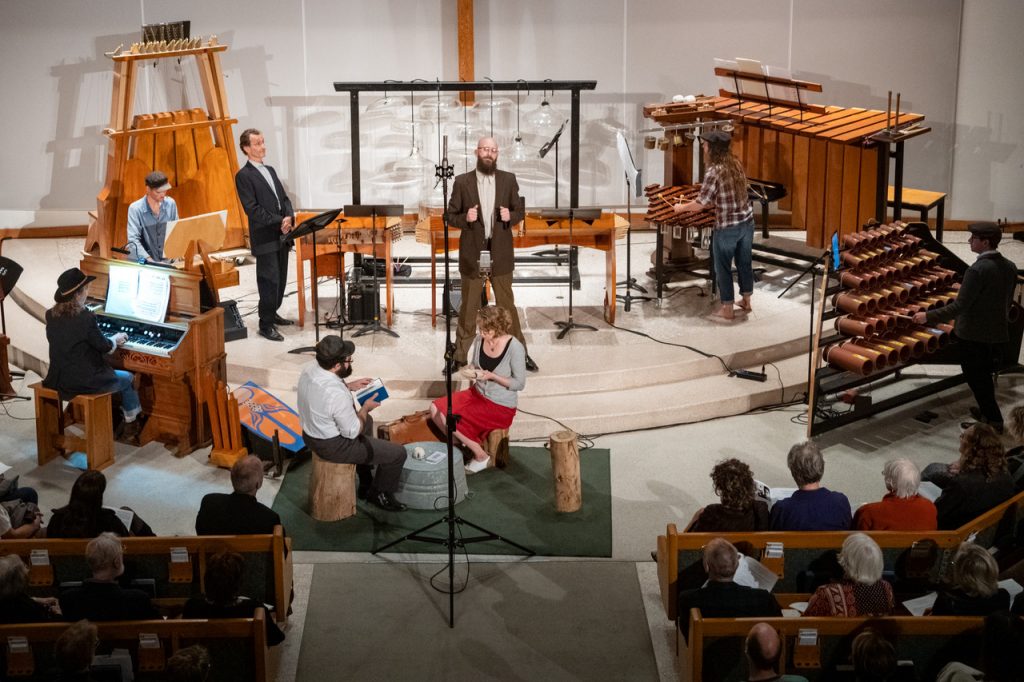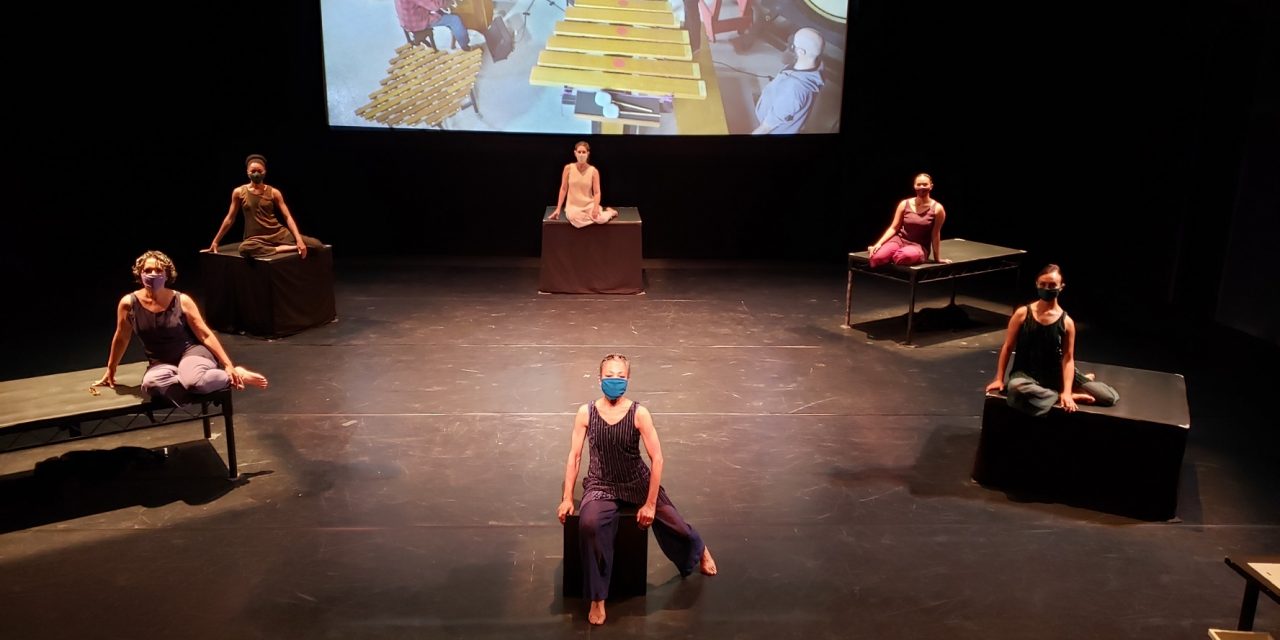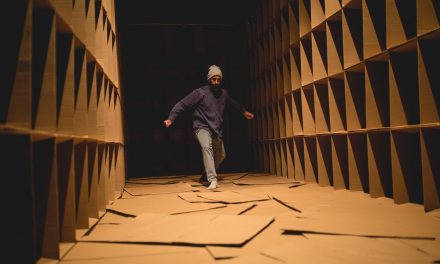Based in Los Angeles, the Grammy Award winning PARTCH Ensemble under the direction of Artistic Director John Schneider and PARTCH Ensemble President T.J. Troy has appeared annually at the Roy and Edna Disney/CalArts Theater (REDCAT) since 2003. In 2020, the pandemic broke that ongoing series, but on June 4-5, 2021, the group returned to REDCAT with PARTCH Ensemble PREMIERES albeit virtually. This was my first experience with the PARTCH Ensemble but having now seen them and because of the amazing assortment of instruments that musician/composer Harry Partch designed and constructed, I will make a point of attending when they are able to appear live once again at REDCAT.
The ensemble premiered seven new works, all designed for Partch instruments, by composers Daniel Corral, Anne LeBaron, Ulrich Krieger, Daniel Rothman, John Schneider, T.J. Troy, and Alex Wand as well as the premiere of the choreography by Sarah Swenson to Partch’s Castor & Pollux – Dance for the Twin Rhythms of Gemini (1952).
Harry Partch (June 24, 1901 – September 3, 1974) was an American composer, music theorist, and creator of custom-made musical instruments and one of the first 20th-century composers in the West to work systematically with microtonal scales. Partch’s family moved to Los Angeles in 1919. He enrolled in the University of Southern California’s School of Music in 1920, but not happy with his teachers, Partch moved to San Francisco and studied music through library books while continuing to compose. In 1923 he came upon the translation of Hermann von Helmholtz’s Sensations of Tone which totally influenced his work leading him to reject the standard twelve-tone equal temperament of Western concert music.
During a brief introduction, John Schneider and T.J. Troy spoke about the challenges of creating the videos during the year of Covid. Because REDCAT was restricted to having only a limited number of people in the theater at one time, the performance could not be videoed as planned. Musicians recorded their parts alone in the privacy of their homes or in the ensemble’s studio, and were later combined by a team of editors. For Castor & Pollux – A Dance for the Twin Rhythms of Gemini, the musicians were videotaped separately of the dancers, resulting in a video within a video. Corey and Troy stated that composers of new works for this concert were limited to five minutes per piece.
The PARTCH Ensemble performs exclusively on the instruments that have been rebuilt based on the designs by Partch and follow his performative philosophies and unique treatment of the human voice. I am not a music critic and therefore I will focus the in-depth portion of my critique on the dancing in Castor & Pollux.
Five-Corner Square (2020) was the first of a trio composed by T.J. Troy featuring musicians Erin Barnes on Diamond Marimba, Nick Terry on Bamboo Marimba, and Troy on Bass Marimba. The piece was lively and high spirited, and as exciting to watch as it was to hear. As the camera, and the editing, moved between each instrument, it offered vital close-up of the musicians at work, offering a rare insider view of how the musicians move their entire bodies while producing the gorgeous sounds that one hears.
Alex Wand was the composer of the second piece Darkness Within Darkness (2020), a much more serene and meditative work. It was inspired by the 6th-century BC Chinese classic text “Tao Te Ching” by Lao Tzu as translated into English by Gia-Fu Feng and Jane English. This piece was part of a longer work that Wand is working on called 81 Tao Songs. It featured Partch instruments the Gourd Tree, two Cloud-Chamber Bowls and the Adapted Guitar No. 1 as well as voices and cello, performed brilliantly by Matt Cook, Derek Stein, Argenta Walther, and Wand.
Darkness Within Darkness is beautiful and often haunting and, for some, enhanced by the kaleidoscope-like effects created by the editors. Less of this, however, would have improved the work for me. I simply shifted my focus off of the computer screen and listened the totally enthralling music.

Partch Ensemble performs “The Wayward: Music of Harry Partch” at the First Presbyterian Church of Santa Monica, Nov. 9, 2019. (Photo/Michael Owen Baker)
Composer Ulrich Krieger explained that Over the Edge of the World (2020) was a response to Partch’s Ulysses at the Edge (1955) which asks the question, what if Ulysses did actually go over the edge of the world? What would he have found there? Krieger takes this question into the present via how today’s scientists think of the universe and the String Theory. Krieger’s music helps imagine what the future of space travel might feel and sound like.
Performed here by Alison Bjorkedal on the Kithara , Matt Cook on Cloud-Chamber Bowls, and Vicki Ray on Chromelodeon, Krieger’s music returned to an earlier genre of works by composers Gordon Mumma, David Tudor, David Behrman, Robert Ashley and Alvin Lucier. It was music that I cut my teeth on in New York back in the 1960s and ‘70s while working with Merce Cunningham and Viola Farber. Here too, it was exciting to watch the musicians perform on these extraordinary instruments created by Harry Partch and to be transported into another realm of possibilities.
Mount San Antonio 1944 (2021) was composed by Daniel Corral featuring Erin Barnes on Diamond Marimba, Vicki Ray on Chromelodeon, John Schneider as vocalist and T.J. Troy on Bass Marimba. The work was inspired by a text written by D. Stewart about a trip over Mount San Antonia and Corral music and tempos reflect that journey, quickening or slowing down accordingly. Though extremely well performed, this work was not as memorable for me as the rest on the program.
The next work was titled feel of the needle when at last you pull the needle through it (2020) and unlike how the title appears here, it was written for the program in the form of a Japanese haiku poem. The composer, Daniel Rothman, scored the piece for Diamond Marimba, Harmonic Canon I, and the Adapted Viola with musicians Erin Barnes, John Schneider and Derek Stein. The music was sparse, poetic and beautifully reminiscent of Japanese music. Each section or musical verse of the haiku was separated by a blackout – necessary?
Anne LeBaron’s Double Helix – from the opera LSD: Huxley’s Last Trip (2020) featured the Libretto by Gerd Stern, Ed Rosenfeld, and Anne LeBaron and featuring Laura Bohn, Vicki Ray, Fahad Siadat, Jim Sullivan, T.J. Troy, and Scott Worthington. The opera, and the use of special effects, transported the audience back in time to the flower generation of drugs, long hair, tie-dyed clothing and psychedelic hallucinations. The performances were great and would stand quite nicely on their own, but here the special effects enhanced the illusion of a mind-altering experience.
Listening to Lu Tzu (2002) was composed and performed by John Schneider on Partch’s Adapted Guitar. As the title suggests, the music, and the instrument, had an aura of ancient China. Added to this, Schneider recited text by Li Po (China, 701-762c.e.) as translated into English by David Hinton. After the previous “trip” Listening to Lu Tzu evoked a much welcomed sense of serenity and wisdom, and for me, one of the highlights of the evening.
The performance finished with the gorgeous work Castor & Pollux – A Dance for the Twin Rhythms of Gemini (1952) featuring the powerful choreography of Sarah Swenson. Divided into two sections: CASTOR – Leda and the Swan and POLLUX – Leda and the Swan, each divided into 4 parts: Insemination, Conception, Incubation and Delivery which followed the phrases of the twins inside the womb.
The work opened with 6 women, each in different positions atop individual platforms. Part I was breathtakingly beautiful in its simplicity as we were introduced to Leda (Cheryl Banks Smith), the Swan (Tamsin Carlson) and the two sets of fraternal twins (Queala Clancy, Tori Cone, Miranda Cox, and Sarah Swenson), and Swenson managed to continue this quality throughout the work
The dance moved through the mythological tale of Leda and the Swan producing twins, but Swenson’s choreography dug more deeply into the mythology of how there were actually two sets of fraternal twins, each sired by separate fathers. There are several versions of this ancient tale, but according to Wikipedia, “Castor was the mortal son of Tyndareus, the king of Sparta, while Pollux was the divine son of Zeus, who seduced Leda in the guise of a swan. The pair are thus an example of heteropteranal superfecundation (the fertilization of two or more ova from the same cycle by sperm from separate acts of sexual intercourse, which can lead to twin babies from two separate biological fathers) Though accounts of their birth are varied, they are sometimes said to have been born from one egg, along with their twin sisters Helen of Troy and Clytemnestra.”
Costumed in unadorned and gorgeous costumes designed by Michael Pacciorini, Swenson depicts the two sets of twins with opposing duets that tell the story of insemination through birth. Each duet has its own quality, but I had a sense of affection, sibling rivalry, and as the myth states, one sharing immortality with the other. Banks Smith was beautiful as Leda and, costumed in all white, Carlson was elegantly regal as the Swan. It is always a joy to watch Swenson perform. She commands the stage during the simplest of movements and she is one of the most grounded dancers I have had the opportunity to witness. It has been a pleasure to watch her choreography continue to grow stronger and increasingly absorbing.
The dance abstractly stayed true to the myth of Castor & Pollux and Swenson’s choreography is genuinely in sync with Partch astonishing atonal score, a score which Partch called “infectious dance music”. Swenson proved him right. Her musicality is brilliant and even when the movement increases in size and scope as it does in her powerful duet with Carlson she remained true to the opening movement’s simplicity, allowing the audience to experience her choreography, dancers, and the story without distracting flourishes. The entire cast of Castor & Pollux was compelling to watch. Again, their names are Tamsin Carlson, Queala Clancy, Tori Cone, Miranda Cox, Cheryl Banks Smith, and Sarah Swenson.
Recording dance can be tricky, and here the camerawork and editing became slightly frustrating because it cut off different body parts, such as the Swan’s head, and these choices denied the audience from completely experiencing Swenson’s intended work. I long to see this and the other PARTCH Ensemble works when they return to REDCAT once the venue reopens for live performances.
Partch’s Castor & Pollux was scored for Harmonic Canon II, Kithara II, Surrogate Kithara, Diamond Marimba, Bass Marimba, and Cloud-Chamber Bowls. The musicians included Erin Barnes, Alison Bjorkedal, Matt Cook, Vicki Ray, John Schneider, Derek Stein, Nick Terry, T.J. Troy, and Alex Wand, with guest musicians Laura Bohn, Fahad Siadat, Jim Sullivan, Argenta Walther, and Scott Worthington.. The Directors of Photography were Austen Zajonc and Melody; Video Director, Jeff Stimmel; and Video Editing and final Broadcast Video Sequencing, Jacob Hurwitz-Goodman.
The PARTCH Ensemble includes Erin Barnes, Alison Bjorkedal, Matt Cook, Vicki Ray, Artistic Director John Schneider, Derek Stein, Nick Terry, T. J. Troy, and Alex Wand; with guest musicians Laura Bohn, Fahad Siadat, Jim Sullivan, Argenta Walther, and Scott Worthington.
[Edit: Revised on 6/10/21 to reflect corrections of PARTCH Ensemble names and titles.]
To visit the PARTCH Ensemble, click HERE.
To learn more about Harry Partch and to see his beautiful musical instruments, click HERE.
To visit the REDCAT website, click HERE.
To learn more about dancer/choreographer Sarah Swenson, click HERE
Written by Jeff Slayton for LA Dance Chronicle.
Featured image: Castor & Pollux – A Dance for the Twin Rhythms of Gemini by Harry Partch, Choreography by Sarah Swenson – Dancers: (clockwise from up-center) Tamsin Carlson, Toni Cone, Miranda Cox, Cheryl Banks Smith, Sarah Swenson, and Queala Clancy – PARTCH Ensemble – Photo: T.J. Troy











